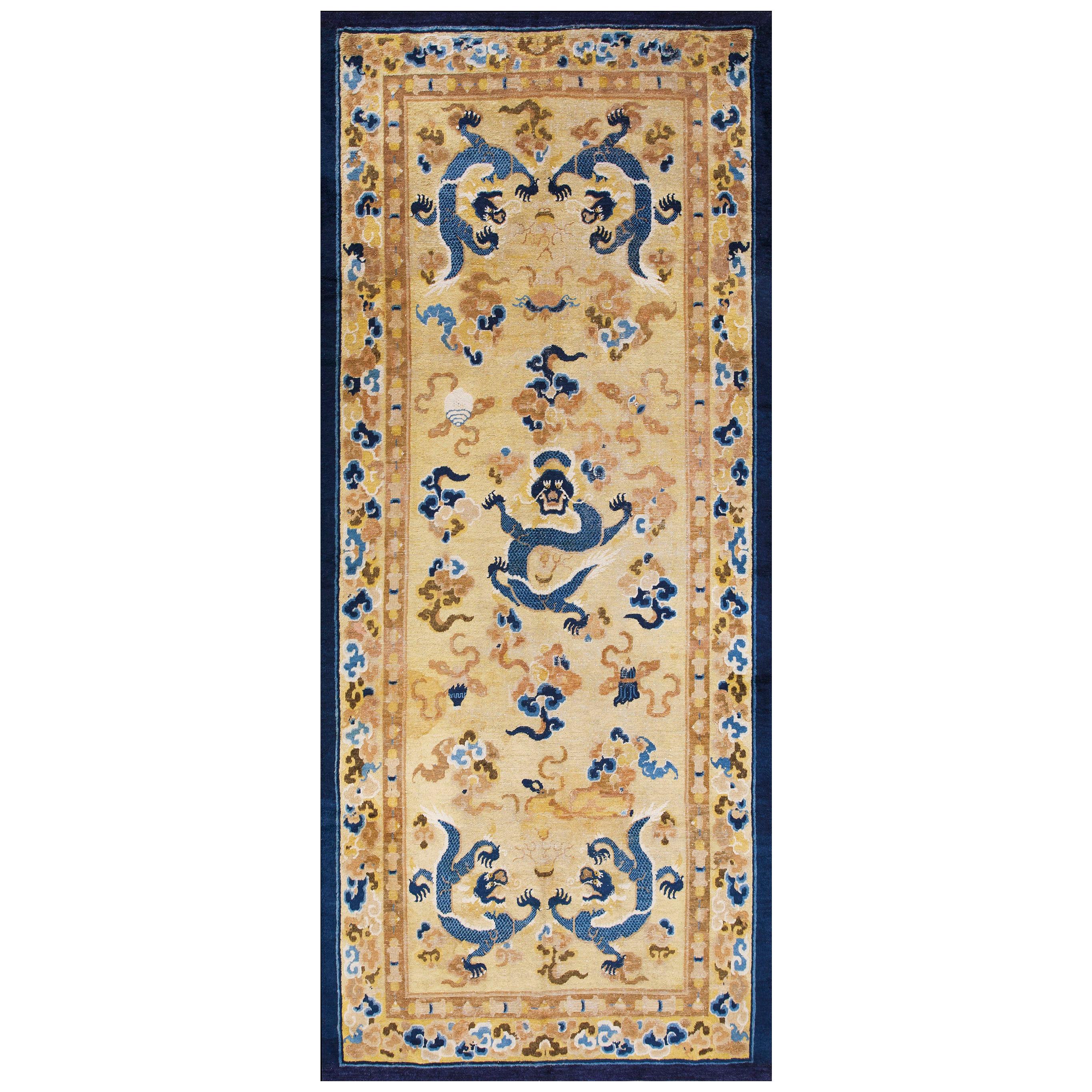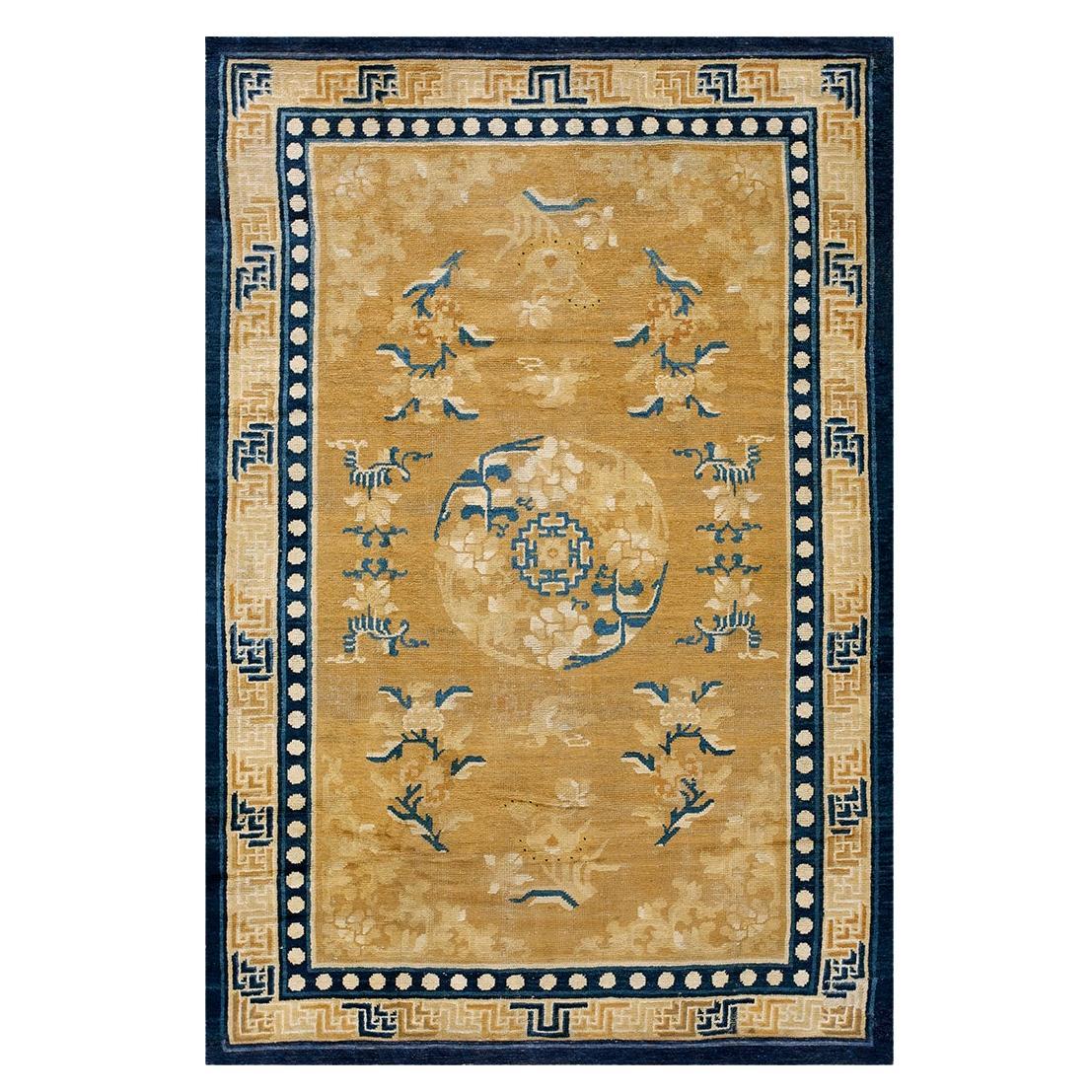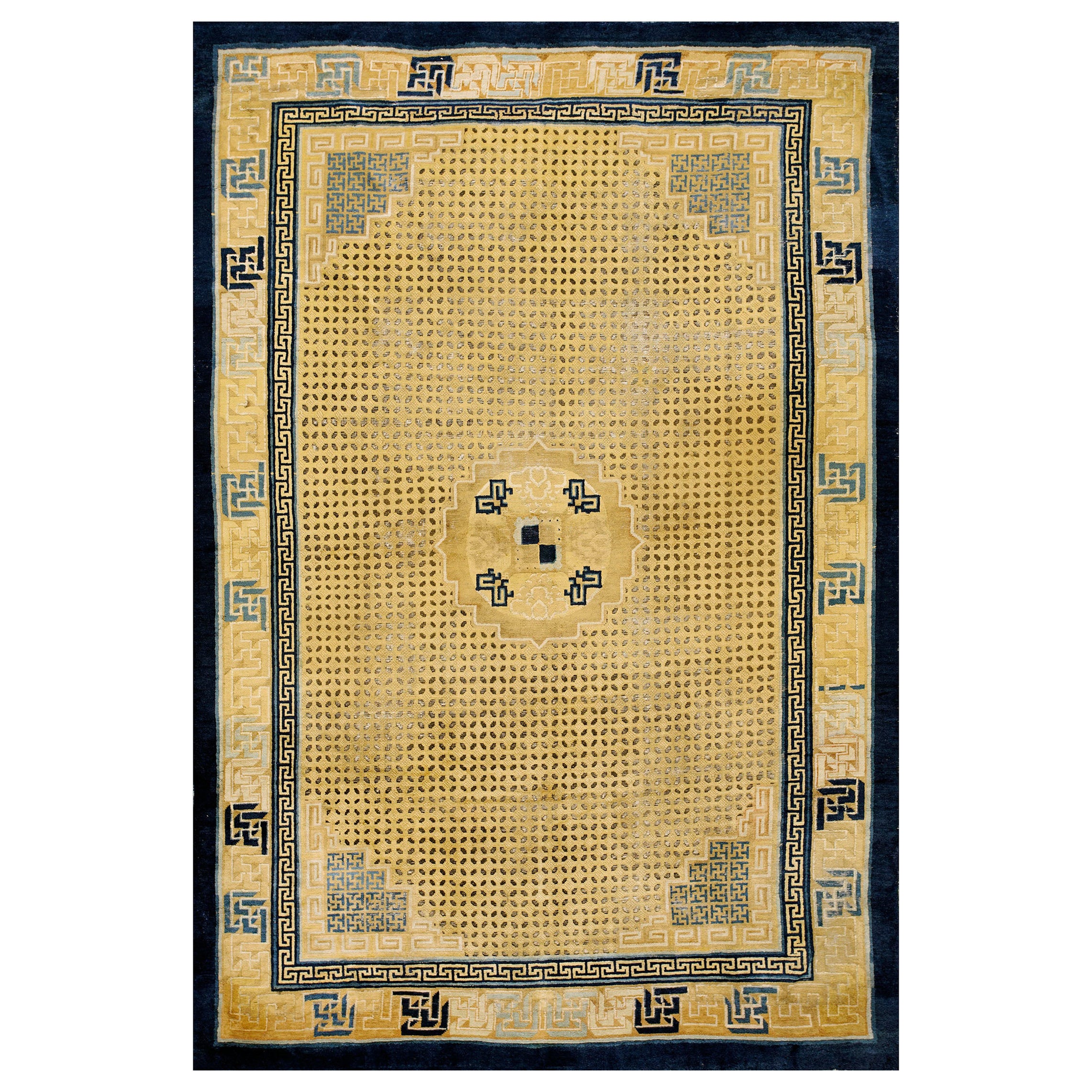Items Similar to Late 18th Century Chinese Ningxia Kang Carpet ( 6' x 10'3" - 175 x 415 )
Want more images or videos?
Request additional images or videos from the seller
1 of 9
Late 18th Century Chinese Ningxia Kang Carpet ( 6' x 10'3" - 175 x 415 )
About the Item
Late 18th Century Chinese Ningxia Kang Carpet ( 6' x 10'3" - 175 x 415 )
Ningxia or Suiyuan, North Central China
K’ang Carpet
Structural Analysis
Warp: cotton, off-white, natural, handspun, Z-4-S;
Weft: cotton, off white, natural, winder plied, Z-3-S. handspun, two shoots alternating;
Pile: wool, Z-3 or Z-4;
Knot: PL,no alternate warp depression, 5 ½ per horizontal inch x 5 per vertical inch = 27 ½ per square inch;
Sides: recovered;
Ends: n.o.
Weft/knots: 50/50, even.
Peach border, medallion and corners corroded; sapphire blue highest.
Remarks.
The golden yellow field employs the classic “grains of rice” pattern with brown pips,
centered by a broadly drawn peach scalloped peony medallion and en-suite corners.
The matching peach tone border has inward facing peonies in one, two or three
colors with short arabesque segments between. There is no corner resolution with
diagonal palmettes. The inner medium dark blue border is pearled and the outermost
stripe is plain as is characteristic of rugs of the period.
The peony corners are bold and direct, without a plethora of intrusive minor
elements. The central peony wreath is pared down as well to the most important
motives. The contrast in scale between the rice grains, a size independent pattern and
the vastly larger scale medallion and corners is particularly striking. The rice pattern is
scale independent in that it is always the same size no matter the overall dimensions of
the rug. The pattern is essentially the same on a 2’ x 4’ as on a 6’ x 10’ carpet.
The attribution to Suiyuan is tentative. The rice grain pattern has often been
assigned to that town as one of its most popular styles. The weave could be either
Ningxia or Suiyuan. Considering that the carpet industry in the latter city was founded
by Ningxia weavers in the early 18th century, the similarity of technique is
understandable
The dating is more opaque. A quick glance seems to indicate the late 18th
century. A closer look at the verso with a balance of wefts and knots gives an early 19th
century era. The back does not resemble earlier rugs. Another indicator is the main
border: the leafy sprays emanating from the palmettes are vertical and straight, curving
only at their ends. Their decoration is spare and simple. The discussion of peony
borders would place them in the 19th century. They lack the filigreed complexity seen
on [………………..], all of which are likely true 18th century pieces. The weave is
particularly coarse, thus making the execution of fine details difficult and they have
generally, been avoided. Taken as a whole, an ascription to Suiyuan in the first quarter
of the 19th century seems defensible
The grains of rice pattern is chronologically invariant and by itself gives no date or period.
The deep corrosion in the peach has allowed the blue details in particular to stand
in relief. The peachy tone is probably a dyewood color, but an exact determination
requires a chemical test.
The single column of Turkish knots along the left edge is a standard practice of
the place and time. Knotting proceeded from left to right. A column of Turkish knots
may also appear on the right hand edge.
NB. The date of the rug is early 19th century and it should be placed below the K’ang carpet line.
- Dimensions:Width: 72 in (182.88 cm)Length: 123 in (312.42 cm)
- Materials and Techniques:Wool,Hand-Knotted
- Place of Origin:
- Period:
- Date of Manufacture:1800
- Condition:Repaired. Wear consistent with age and use.
- Seller Location:New York, NY
- Reference Number:
About the Seller
4.8
Platinum Seller
These expertly vetted sellers are 1stDibs' most experienced sellers and are rated highest by our customers.
Established in 1995
1stDibs seller since 2019
343 sales on 1stDibs
Typical response time: <1 hour
- ShippingRetrieving quote...Ships From: New York, NY
- Return PolicyA return for this item may be initiated within 3 days of delivery.
More From This SellerView All
- Late 18th Century Chinese Ningxia Kang Carpet ( 5'9" x 13'8" - 175 x 415 )Located in New York, NYLate 18th Century Chinese Ningxia Kang Carpet ( 5'9" x 13'8" - 175 x 415 ) Five dragons writhe and soar on a light yellow ground on this classically rendered long carpet from norther...Category
Antique Early 1800s Chinese Chinese and East Asian Rugs
MaterialsWool
- Late 18th Century Chinese Ningxia Carpet ( 4'10" x 6'10" - 147 x 208 )Located in New York, NYLate 18th Century Chinese Ningxia Carpet ( 4'10" x 6'10" - 147 x 208 )Category
Antique 1790s Chinese Chinese and East Asian Rugs
MaterialsWool
- Late 18th Century Chinese Ningxia Carpet ( 5' x 8' 1'' - 152 x 246 cm )Located in New York, NYLate 18th Century Chinese Ningxia Carpet ( 5' x 8' 1'' - 152 x 246 cm )Category
Antique 1770s Chinese Chinese and East Asian Rugs
MaterialsWool
- 18th Century Chinese Ningxia Carpet ( 7' x 10' 2''- 213 x 309 cm)Located in New York, NY3rd Quarter Of 18th Century Chinese Ningxia Carpet With Grain of Rice Pattern ( 7' x 10' 2'' - 213 x 309 cm)Category
Antique 1770s Chinese Qing Chinese and East Asian Rugs
MaterialsWool
- 18th Century W. Chinese Ningxia K'ang Carpet ( 4'10" x 10' )Located in New York, NY18th Century W. Chinese Ningxia K'ang Carpet ( 4'10" x 10' )Category
Antique 1750s Chinese Chinese and East Asian Rugs
MaterialsWool
- Late 18th Century Chinese Ningxia Carpet ( 13'6" x 16'6" - 412 x 503 )Located in New York, NYLate 18th Century Chinese Ningxia Carpet ( 13'6" x 16'6" - 412 x 503 )Category
Antique 1790s Chinese Chinese and East Asian Rugs
MaterialsWool
You May Also Like
- Antique Chinese Ningxia Carpet Rug, Late 19th CenturyLocated in San Francisco, CAAntique Chinese Ningxia Carpet Rug, Late 19th Century This elegant Chinese Ningxia carpet draws a central roundel composed of lotuses flanked by slightly smaller roundels of the sam...Category
Antique Late 19th Century Chinese Chinese and East Asian Rugs
MaterialsWool
- Vintage Chinese Rug Carpet Circa 1940 10'3 x 13'10Located in Secaucus, NJA Chinese vintage circa 1940s handwoven rug. The deep navy ground has wonderful delicate floral designs in ivory and blues. The major border and four minor borders surrounding the fi...Category
Early 20th Century Chinese Chinese and East Asian Rugs
MaterialsWool
- Antique 18th Century Chinese Ningxia Rug. 6 ft x 9 ft 9 inLocated in New York, NYA magnificent rare and collectible antique 18th century Chinese Ningxia rug, country of origin / rug type: antique Chinese rugs, date: circa late 18th century. Size: 6 ft x 9 ft 9 in (1.83 m x 2.97 m) Antique Chinese Ningxia carpets have a transcendent quality that has made them highly sought-after since the 17th century. If one were to judge from this excellent 18th-century Ningxia rug, it is easy to see how this came to be so. The level of detail in this antique Chinese carpet is found in very few places around the world. The colors blend harmoniously to show off the fine craftsmanship of this carpet from China. Ningxia is located in a harsh mountainous region are Northwestern China. It borders Mongolia and sits on the plain of the Yellow River, bounded by the Great Wall of China on its Northeastern border. The climate of this region made it perfect for growing strong, yet soft wool. Little is known about antique rugs from this region before the 17th century because of its remote location. A visit from the Kangxi Emperor in 1696 and 1697 brought these carpets to the world. He was struck by the beauty and quality of the carpets he found and decided to establish a royal carpet weaving center in the area. After the establishment of the rug weaving centers of the Royal Court, designs in Ningxia became more formal and reflected the tastes of the Chinese Courts and noblemen. Carpets from the area became a symbol of wealth and power. At the time when this carpet was created, the royal weaving centers had been operating for about 100 years. By this time, Ningxia had become a name that was associated with high-quality antique rugs. This early carpet uses a complex range of blues, rose, pinks, light browns, dark browns and ivory. The design uses subtle shading to give it depth and create areas of shadow and light within the individual motifs. It based on a medallion design with four rondels in the field. It is executed with precision and demonstrates focused attention to symmetry. The center border of the carpet is surrounded by what is known to the Chinese as a cloud and thunder pattern, also known as a meander or Greek key pattern. To the Chinese, this pattern represents the cloud and thunder that brings the life-giving rain and the promise of good crops. It has been found in Chinese art as far back as 1050 BC. The pile of the rug is soft and supple, and it has a fine weave, more like a heavy textile than a carpet. This is one of the qualities for which Ningxia carpets were known. The level of detail and intricacy of the design is one of the fascinating aspects of the rug. For instance, if you look between the regularly spaced motifs in the field of the carpet, you will see that they are not solid, but contain a delicate pattern of precisely executed dots. This carpet has a high knot count, which is what makes the intricacy of this design possible. Another remarkable quality of this antique Oriental rug is its excellent shape that it is in for its age. This suggests that this carpet was well cared for over the past several centuries. This antique 18th Century Chinese Ningxia rug is an example of fine quality craftsmanship and work that was produced by the Ningxia Court rug weavers. The design and colors come together beautifully to create a piece of classic Chinese artwork. It is a special piece that would be a beautiful addition to any Oriental collection...Category
Antique Late 18th Century Chinese Chinese Export Chinese and East Asian ...
MaterialsWool
- Distressed 18th Century Antique Ningxia Chinese Narrow Runner RugLocated in Milan, ITAn exquisitely elegant early Temple runner from the Ningxia region in northwest China, commissioned in the early 18th century for a Buddhist monastery in Tibet. The pattern is compos...Category
Antique Early 18th Century Chinese Ming Chinese and East Asian Rugs
MaterialsWool
- Chinese Ningxia Square Little CarpetLocated in Alessandria, PiemonteRare square little Chinese Ningxia carpet, simple and elegant for everywhere.Category
Mid-20th Century Chinese Chinese Export Chinese and East Asian Rugs
MaterialsWool
- 18th Century Chinese Ningxia Rug with Floral Medallion and ButterfliesLocated in Milan, ITCharacterised by the delicate drawing which distinguishes the weavings of the short and noble Yongzheng period (1723-1735), it has a beautifully drawn...Category
Antique Mid-18th Century Chinese Ming Chinese and East Asian Rugs
MaterialsWool
Recently Viewed
View AllMore Ways To Browse
Fine Antique China
Antique Fine China
Chinese S
Chinese 19th Blue
Chinese Scale
Pearl China
Yellow And Blue Chinese
Chinese Blue Pieces
Chinese Style White Furniture
Antique Blue China Pattern
Chinese Large Carpet
Matching China
Blue And White Fine China
Chinese Medallion Carpet
18th Blue And White Chinese
18th Century Blue White China
Chinese Blue And White 18th Century
Antique Chinese Scale





